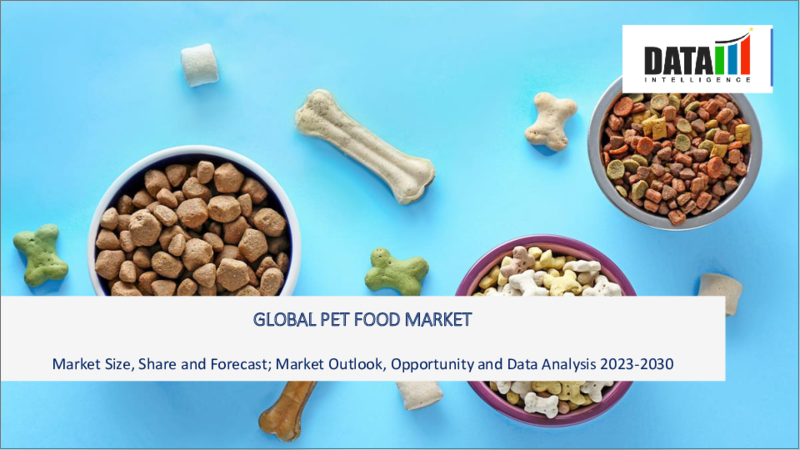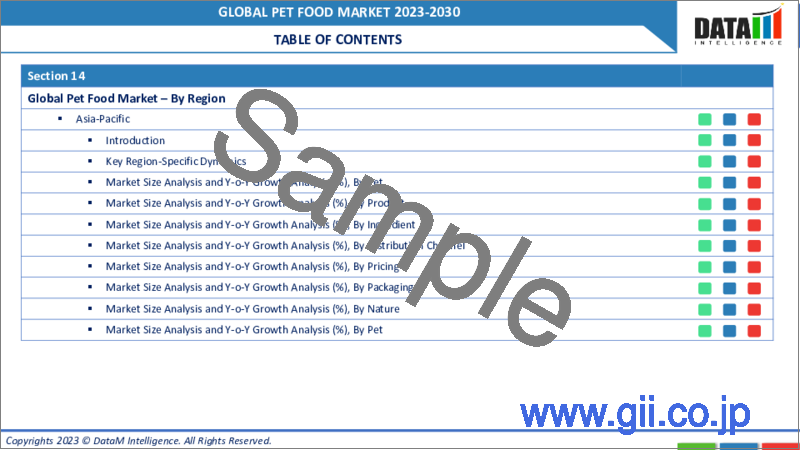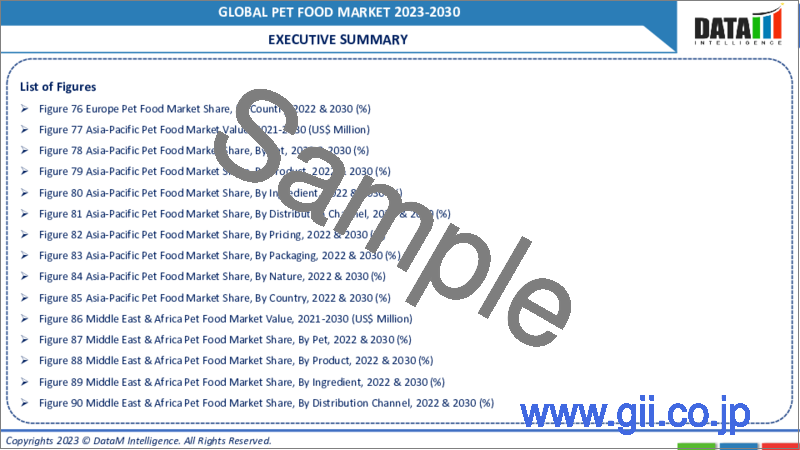|
|
市場調査レポート
商品コード
1319212
ペットフードの世界市場-2023年~2030年Global Pet Food Market - 2023-2030 |
||||||
カスタマイズ可能
適宜更新あり
|
|||||||
| ペットフードの世界市場-2023年~2030年 |
|
出版日: 2023年07月31日
発行: DataM Intelligence
ページ情報: 英文 190 Pages
納期: 即日から翌営業日
|
- 全表示
- 概要
- 目次
市場概要
世界のペットフード市場は、2022年に1,203億米ドルに達し、2023年から2030年の予測期間中にCAGR 5.1%で成長し、2030年には1億7,900万米ドルに達すると予測されています。
ペットフードとは、犬や猫などのペットの栄養ニーズを満たすために特別に処方された食品を指します。ドッグフード、キャットフード、ペット用おやつなど、幅広い製品が含まれます。ペットフードの原材料は、これらの製品の品質と栄養価を決定する上で重要な役割を果たしています。動物性タンパク源はペットフードの必須成分であり、ペットの成長と維持に必要なアミノ酸や栄養素を供給します。
ペットの飼い主は、ペットの健康をより意識するようになり、全体的な健康を促進するペットフード製品を求めるようになっています。体重管理、関節サポート、消化器系の健康、免疫系サポートなど、特定の健康効果を持つペットフードの需要が高まっています。プロバイオティクス、抗酸化物質、オメガ3脂肪酸などの機能性成分がペットフードに配合されるケースが増えています。
市場力学
世界のペット飼育数の増加がペットフード市場を牽引
ペットの飼育は世界の重要な動向と考えられており、ペットを家族に迎える家庭が増えています。さまざまな地域や文化圏で、ペットは大切な伴侶であり家庭の一員となっています。米国ペット製品協会の2021-2022年全国ペット飼育者調査によると、米国では70%の世帯が何らかのペットを飼っており、1988年には56%でした。このような文化的変化が、愛するペットの栄養ニーズに応えるペットフード製品の需要を高めています。
さらに、都市化やライフスタイルの変化も、ペット飼育の動向に影響を与えています。都市部では、居住スペースが狭く、屋外に出る機会も少なくなることが多いです。ペット、特に小型の犬種や猫は都市環境に適しており、広いスペースを必要とせずに仲間とのふれあいを提供できます。このため、特に都市生活者の間でペットの飼育率が高くなり、ペットフード市場の成長にさらに貢献しています。
自然食品とオーガニック・ペットフードに対する需要の増加がペットフード市場を促進すると予想される
食品部門を含むさまざまな産業で、自然食品やオーガニック製品に対する消費者の動向が広がっていることが確認されています。この動向はペットフード市場にも及んでおり、ペットの飼い主は自分たちが優先するのと同じ品質と栄養基準をペットにも与えようとしています。天然素材やオーガニック素材をペットに与えたいという願望は、多くの飼い主の健康志向と一致しています。
さらに、天然やオーガニックのペットフード製品は、人工的な添加物や保存料、遺伝子組み換え原料を使用しておらず、ペットにとってより健康的な選択肢であると認識されています。ペットの飼い主は、これらの製品がペットの全体的な健康を増進し、人工的または加工された原材料の摂取に関連する健康問題のリスクを低減できると考えています。こうした認識が、ナチュラル・ペットフードやオーガニック・ペットフードの需要を押し上げています。
原材料価格の変動がペットフード市場の足かせとなっている
厳しい規制とラベリング要件は、食品コーティング剤メーカーのコンプライアンス・コストを増加させる可能性があります。安全基準、品質管理対策、ラベリング規制を遵守するためには、追加的な資源と投資が必要になることが多いです。こうしたコストはメーカーの収益性や競争力に影響を及ぼし、製品提供の革新や拡大が制限される可能性があります。
規制により、人工添加物、保存料、アレルギー物質など、食品コーティングに使用される特定の原材料に制限や制約が課される場合があります。これらの規制を遵守するためには、製品の再製造、代替原料の調達、研究開発への投資が必要となる場合があります。こうした課題は、新しく革新的なペットフードの市場導入を妨げる可能性があります。
COVID-19影響分析
COVID-19分析には、COVID前シナリオ、COVIDシナリオ、COVID後シナリオに加え、価格力学(COVID前シナリオと比較したパンデミック中およびパンデミック後の価格変動を含む)、需給スペクトラム(取引制限、封鎖、およびその後の問題による需給の変化)、政府の取り組み(政府機関による市場、セクター、産業を活性化させる取り組み)、メーカーの戦略的取り組み(COVID問題を緩和するためにメーカーが行ったことをここで取り上げる)が含まれます。
目次
第1章 調査手法と調査範囲
第2章 市場の定義と概要
第3章 エグゼクティブサマリー
第4章 市場力学
- 市場への影響要因
- 促進要因
- 世界のペット飼育数の増加
- ナチュラル・オーガニックペットフードに対する需要の増加
- 抑制要因
- 原材料価格の変動
- 機会
- 影響分析
- 促進要因
第5章 業界分析
- ポーターのファイブフォース分析
- サプライチェーン分析
- 価格分析
- 規制分析
第6章 COVID-19分析
第7章 製品別
- ウェットペットフード
- ドライペットフード
- 動物用飼料
第8章 価格別
- エコノミー
- プレミアム
- スーパープレミアム
第9章 用途別
- 犬
- 猫
- 鳥類
- その他
第10章 流通チャネル別
- 専門ペットショップ
- スーパーマーケット/ハイパーマーケット
- オンライン
- その他
第11章 地域別
- 北米
- 米国
- カナダ
- メキシコ
- 欧州
- ドイツ
- 英国
- フランス
- イタリア
- スペイン
- その他欧州
- 南米
- ブラジル
- アルゼンチン
- その他南米
- アジア太平洋
- 中国
- インド
- 日本
- オーストラリア
- その他アジア太平洋地域
- 中東・アフリカ
第12章 競合情勢
- 競合シナリオ
- 市況/シェア分析
- M&A分析
第13章 企業プロファイル
- Big Heart Pet Brands
- 会社概要
- 製品ポートフォリオと説明
- 財務概要
- 主な発展
- Blue Buffalo
- Deuerer
- Heristo AG
- Hill's Pet Nutrition
- Laroy Group
- Mars Petcare Inc
- Nestle Purina PetCare
- Spectrum Brands/United Pet Group
- Unicharm Corp.
第14章 付録
Market Overview
Global Pet Food Market reached US$ 120.3 billion in 2022 and is expected to reach US$ 179.0 million by 2030 growing with a CAGR of 5.1% during the forecast period 2023-2030.
Pet food refers to specially formulated food products designed to meet the nutritional needs of pets, such as dogs and cats. It includes a wide range of products, including dog food, cat food, pet treats, and more. Pet food ingredients play a crucial role in determining the quality and nutritional value of these products. Animal protein sources are essential components of pet food, providing the necessary amino acids and nutrients for pets' growth and maintenance.
Pet owners are becoming more conscious of their pets' health and are seeking pet food products that promote overall well-being. There is a rising demand for pet food with specific health benefits, such as weight management, joint support, digestive health, and immune system support. Functional ingredients like probiotics, antioxidants, and omega-3 fatty acids are increasingly incorporated into pet food formulations.
Market Dynamics
Increasing Pet Ownership Globally is Driving the Pet Food Market
Pet ownership is considered a significant global trend, with a growing number of households welcoming pets into their families. Across different regions and cultures, pets have become valued companions and members of the household. According to American Pet Products Association's 2021-2022 National Pet Owners Survey, 70% of households in the US owned a type of pet as compared to 56% in 1988. This cultural shift has contributed to a higher demand for pet food products to cater to the nutritional needs of these beloved pets.
Additionally, urbanization and changing lifestyles have influenced the rising pet ownership trend. In urban areas, people often have smaller living spaces and less access to outdoor areas. Pets, particularly smaller breeds, and cats, are well-suited to urban environments and can provide companionship without requiring large spaces. This has resulted in a higher adoption rate of pets, especially among urban dwellers, further contributing to the growth of the pet food market.
Increasing Demand for Natural and Organic Pet Food is Expected to Foster the Pet Food Market
It is been observed that there is a broader consumer trend towards natural and organic products in various industries, including the food sector. This trend has extended to the pet food market as well, as pet owners seek to provide their pets with the same quality and nutritional standards they prioritize for themselves. The desire to feed pets with natural and organic ingredients aligns with the overall health-conscious mindset of many pet owners.
Furthermore, natural and organic pet food products are perceived as healthier options for pets, free from artificial additives, preservatives, and genetically modified ingredients. Pet owners believe that these products can enhance their pets' overall well-being and reduce the risk of health issues related to consuming artificial or processed ingredients. This perception drives the demand for natural and organic pet food.
Raw Material Price Volatility is Holding Back the Pet Food Market
Stringent regulations and labeling requirements can increase compliance costs for food coating ingredient manufacturers. Compliance with safety standards, quality control measures, and labeling regulations often requires additional resources and investments. These costs can impact the profitability and competitiveness of manufacturers, potentially limiting their ability to innovate and expand product offerings.
Regulations may impose restrictions or limitations on certain ingredients used in food coatings, such as artificial additives, preservatives, or allergenic substances. Compliance with these restrictions may require reformulation of products, sourcing alternative ingredients, or investing in research and development. Such challenges can hinder the introduction of new and innovative pet food into the market.
COVID-19 Impact Analysis
The COVID-19 Analysis includes Pre-COVID Scenario, COVID Scenario, and Post-COVID Scenario along with Pricing Dynamics (Including pricing change during and post-pandemic comparing it with pre-COVID scenarios), Demand-Supply Spectrum (Shift in demand and supply owing to trading restrictions, lockdown, and subsequent issues), Government Initiatives (Initiatives to revive market, sector or Industry by Government Bodies) and Manufacturers Strategic Initiatives (What manufacturers did to mitigate the COVID issues will be covered here).
Segment Analysis
The global pet food market is segmented based on product, price, application, distribution channel, and region.
By Price, the Premium Segment is Estimated to have Significant Growth During the Forecast Period
Pet owners increasingly prioritize the health and well-being of their pets, considering them as valued family members. This mindset has translated into a willingness to invest in premium pet food products that offer higher-quality ingredients and specialized formulations. For instance, U.S. dog owners spent an average of US$287 on dog food in 2020, while cat owners spent US$254 on cat food. Both amounts represented an approximate 11% increase from two years before. Pet owners perceive premium pet food as providing better nutrition, which can contribute to their pets' overall health, vitality, and longevity.
Additionally, the premium segment is often associated with natural and organic pet food options. Pet owners who value natural and organic ingredients are more likely to choose premium products over conventional ones. This preference stems from the belief that natural and organic ingredients are free from artificial additives, preservatives, and genetically modified organisms, aligning with the desire to provide their pets with the best possible nutrition.
Geographical Analysis
Asia Pacific is the Fastest Growing Market in the Pet Food Market
The Asia Pacific region has witnessed a significant increase in pet ownership and pet population in recent years. Rising urbanization, improving economic conditions, and changing lifestyles have led to a greater number of households embracing pet ownership. As more people welcome pets into their families, the demand for pet food has naturally surged, driving the growth of the market in the region.
The rising middle-class population in countries like China, India, and Southeast Asian nations has resulted in increased disposable incomes. This has translated into greater spending power for pet owners, enabling them to invest in higher-quality pet food products. The willingness to provide premium and specialized pet food options further propels the growth of the pet food market in the region.
Competitive Landscape
The major global players in the market include: Big Heart Pet Brands, Blue Buffalo, Deuerer, Heristo AG, Hill's Pet Nutrition, Laroy Group, Mars Petcare Inc, Nestle Purina PetCare, Spectrum Brands / United Pet Group, and Unicharm Corp.
Why Purchase the Report?
- To visualize the global pet food market segmentation based on product, price, application, distribution channel, and region, as well as understand key commercial assets and players.
- Identify commercial opportunities in the market by analyzing trends and co-development.
- Excel data sheet with numerous data points of pet food market-level with all segments.
- The PDF report consists of cogently put-together market analysis after exhaustive qualitative interviews and in-depth market study.
- Product mapping is available as Excel consists of key products of all the major market players.
The global pet food market report would provide approximately 69 tables, 69 figures and 190 Pages.
Target Audience 2023
- Manufacturers/ Buyers
- Industry Investors/Investment Bankers
- Research Professionals
- Emerging Companies
Table of Contents
1. Methodology and Scope
- 1.1. Research Methodology
- 1.2. Research Objective and Scope of the Report
2. Market Definition and Overview
3. Executive Summary
- 3.1. Market Snippet, by Product
- 3.2. Market Snippet, by Price
- 3.3. Market Snippet, by Application
- 3.4. Market Snippet, by Distribution Channel
- 3.5. Market Snippet, by Region
4. Market Dynamics
- 4.1. Market Impacting Factors
- 4.1.1. Drivers
- 4.1.1.1. Increasing Pet Ownership Globally
- 4.1.1.2. Increasing Demand for Natural and Organic Pet Food
- 4.1.2. Restraints
- 4.1.2.1. Raw Material Price Volatility
- 4.1.3. Opportunity
- 4.1.4. Impact Analysis
- 4.1.1. Drivers
5. Industry Analysis
- 5.1. Porter's Five Force Analysis
- 5.2. Supply Chain Analysis
- 5.3. Pricing Analysis
- 5.4. Regulatory Analysis
6. COVID-19 Analysis
- 6.1. Analysis of COVID-19 on the Market
- 6.1.1. Scenario Before COVID-19
- 6.1.2. Scenario During COVID-19
- 6.1.3. Scenario Post COVID-19
- 6.2. Pricing Dynamics Amid COVID-19
- 6.3. Demand-Supply Spectrum
- 6.4. Government Initiatives Related to the Market During Pandemic
- 6.5. Manufacturers Strategic Initiatives
- 6.6. Conclusion
7. By Product
- 7.1. Introduction
- 7.1.1. Market Size Analysis and Y-o-Y Growth Analysis (%), By Product
- 7.1.2. Market Attractiveness Index, By Product
- 7.2. Wet Pet Food*
- 7.2.1. Introduction
- 7.2.2. Market Size Analysis and Y-o-Y Growth Analysis (%)
- 7.3. Dry Pet Food
- 7.4. Veterinary Diets
8. By Price
- 8.1. Introduction
- 8.1.1. Market Size Analysis and Y-o-Y Growth Analysis (%), By Price
- 8.1.2. Market Attractiveness Index, By Price
- 8.2. Economic*
- 8.2.1. Introduction
- 8.2.2. Market Size Analysis and Y-o-Y Growth Analysis (%)
- 8.3. Premium
- 8.4. Super Premium
9. By Application
- 9.1. Introduction
- 9.1.1. Market Size Analysis and Y-o-Y Growth Analysis (%), By Application
- 9.1.2. Market Attractiveness Index, By Application
- 9.2. Dog*
- 9.2.1. Introduction
- 9.2.2. Market Size Analysis and Y-o-Y Growth Analysis (%)
- 9.3. Cat
- 9.4. Bird
- 9.5. Others
10. By Distribution Channel
- 10.1. Introduction
- 10.1.1. Market Size Analysis and Y-o-Y Growth Analysis (%), By Distribution Channel
- 10.1.2. Market Attractiveness Index, By Distribution Channel
- 10.2. Specialty Pet Shops*
- 10.2.1. Introduction
- 10.2.2. Market Size Analysis and Y-o-Y Growth Analysis (%)
- 10.3. Supermarkets/Hypermarkets
- 10.4. Online
- 10.5. Others
11. By Region
- 11.1. Introduction
- 11.1.1. Market Size Analysis and Y-o-Y Growth Analysis (%), By Region
- 11.1.2. Market Attractiveness Index, By Region
- 11.2. North America*
- 11.2.1. Introduction
- 11.2.2. Key Region-Specific Dynamics
- 11.2.3. Market Size Analysis and Y-o-Y Growth Analysis (%), By Product Type
- 11.2.4. Market Size Analysis and Y-o-Y Growth Analysis (%), By Price
- 11.2.5. Market Size Analysis and Y-o-Y Growth Analysis (%), By Application
- 11.2.6. Market Size Analysis and Y-o-Y Growth Analysis (%), By Distribution Channel
- 11.2.7. Market Size Analysis and Y-o-Y Growth Analysis (%), By Country
- 11.2.7.1. The U.S.
- 11.2.7.2. Canada
- 11.2.7.3. Mexico
- 11.3. Europe
- 11.3.1. Introduction
- 11.3.2. Key Region-Specific Dynamics
- 11.3.3. Market Size Analysis and Y-o-Y Growth Analysis (%), By Product Type
- 11.3.4. Market Size Analysis and Y-o-Y Growth Analysis (%), By Price
- 11.3.5. Market Size Analysis and Y-o-Y Growth Analysis (%), By Application
- 11.3.6. Market Size Analysis and Y-o-Y Growth Analysis (%), By Distribution Channel
- 11.3.7. Market Size Analysis and Y-o-Y Growth Analysis (%), By Country
- 11.3.7.1. Germany
- 11.3.7.2. The U.K.
- 11.3.7.3. France
- 11.3.7.4. Italy
- 11.3.7.5. Spain
- 11.3.7.6. Rest of Europe
- 11.4. South America
- 11.4.1. Introduction
- 11.4.2. Key Region-Specific Dynamics
- 11.4.3. Market Size Analysis and Y-o-Y Growth Analysis (%), By Product Type
- 11.4.4. Market Size Analysis and Y-o-Y Growth Analysis (%), By Price
- 11.4.5. Market Size Analysis and Y-o-Y Growth Analysis (%), By Application
- 11.4.6. Market Size Analysis and Y-o-Y Growth Analysis (%), By Distribution Channel
- 11.4.7. Market Size Analysis and Y-o-Y Growth Analysis (%), By Country
- 11.4.7.1. Brazil
- 11.4.7.2. Argentina
- 11.4.7.3. Rest of South America
- 11.5. Asia-Pacific
- 11.5.1. Introduction
- 11.5.2. Key Region-Specific Dynamics
- 11.5.3. Market Size Analysis and Y-o-Y Growth Analysis (%), By Product Type
- 11.5.4. Market Size Analysis and Y-o-Y Growth Analysis (%), By Price
- 11.5.5. Market Size Analysis and Y-o-Y Growth Analysis (%), By Application
- 11.5.6. Market Size Analysis and Y-o-Y Growth Analysis (%), By Distribution Channel
- 11.5.7. Market Size Analysis and Y-o-Y Growth Analysis (%), By Country
- 11.5.7.1. China
- 11.5.7.2. India
- 11.5.7.3. Japan
- 11.5.7.4. Australia
- 11.5.7.5. Rest of Asia-Pacific
- 11.6. Middle East and Africa
- 11.6.1. Introduction
- 11.6.2. Key Region-Specific Dynamics
- 11.6.3. Market Size Analysis and Y-o-Y Growth Analysis (%), By Product Type
- 11.6.4. Market Size Analysis and Y-o-Y Growth Analysis (%), By Price
- 11.6.5. Market Size Analysis and Y-o-Y Growth Analysis (%), By Application
- 11.6.6. Market Size Analysis and Y-o-Y Growth Analysis (%), By Distribution Channel
12. Competitive Landscape
- 12.1. Competitive Scenario
- 12.2. Market Positioning/Share Analysis
- 12.3. Mergers and Acquisitions Analysis
13. Company Profiles
- 13.1. Big Heart Pet Brands*
- 13.1.1. Company Overview
- 13.1.2. Product Portfolio and Description
- 13.1.3. Financial Overview
- 13.1.4. Key Developments
- 13.2. Blue Buffalo
- 13.3. Deuerer
- 13.4. Heristo AG
- 13.5. Hill's Pet Nutrition
- 13.6. Laroy Group
- 13.7. Mars Petcare Inc
- 13.8. Nestle Purina PetCare
- 13.9. Spectrum Brands / United Pet Group
- 13.10. Unicharm Corp.
LIST NOT EXHAUSTIVE
14. Appendix
- 14.1. About Us and Services
- 14.2. Contact Us






